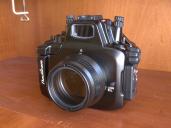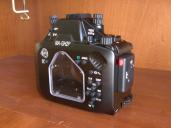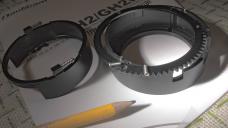
-
After returning from my recent vacation at Curacao - which was all about diving and trying out the underwater housing I bought for my GH2 - I wondered if anyone was interested in sharing experiences with regards to underwater videography using the GH2, and the unavoidable post processing it requires?
If you want to watch the underwater video that I produced at Curacao, you can download or play it directly from archive.org - this link is to the 18 MBit/s .mp4 file that I encoded (size 3.6 GB), you can also watch a seriously down-scaled / low-quality / low-bandwidth version here.
I used FlowMotion 2.02 in 24H mode, the 14-42mm Vario X and no artificial light to produce the above linked vieo.
-
@karl I am downloading your MP4 (not arrived yet) I was just considering an actioncam to film under water (€199 Sony HDR-AS10) As I am not considering to basejump/motorcross/ etc it might be more easy to just get an underwater housing for my GH2. So Which one did you buy, and is it completely safe/ waterproof?
-
@tommy: Hope your download has succeded by now and you like what you got? :-)
"Action cams" like the one you mention have the obvious advantage that they are small, light-weight and relatively cheap, but their small sensors and low resolution are reason enough to not expect a result anywhere near from what you can get from a GH2. Also, when I look at the product images of the HDR-AS10, I seriously doubt that it is operable at usual diving depths - just look at its knobs, the way they are build will likely cause them to involuntarily trigger due to water pressure. I would rather not try to use such a cam for any under water activity beyond snorkeling.
Getting an underwater housing for the GH2 is certainly easy, but also pretty expensive. AFAIK, there are currently two models offered: The Nauticam NA-GH2P that I bought - at a price of ~2200,- € - and a housing from 10bar which is somewhat cheaper, but which I did not consider because I was displeased with the quality of an underwater accessory for an older camera that I had bought from 10bar.
Is the housing completely safe/waterproof? Well, Nauticam specs its GH2 housing for dives up to 100 metres depth, and so far no water entered the housing I bought. Yet Nauticam rejects liability for damages to the camera should the housing fail. I wonder what happenes when somebody puts a case of flooding before a court. The Epoque housing that I used before I bought the GH2 let in a few drops after ~350 dives, my old Sanyo camera did not take damage but I decided to not use the Epoque housing after that. Generally speaking, O-rings used in such housings do age, and will fail one day if they are not exchanged before. But with proper maintenance, you can use quality underwater housings for many years.
-
I have the NA-GH2P which I brought several times to 85m deep. So far no water :)
Why don't you upload your video on Vimeo. Also with free account is easy to watch
Bye
-
@Karl thanks. Actually I did not manage to download it. Vimeo would be more easy. But i am not a diver and it would be more for fun and extra cam for some extraordinary cases so I am not going to pay 2000 euro for a case. I will probably wait for some more reviews from the Sony action cam . Thanks
-
@LongJohnSilver: Good to hear positive experiences with that housing... for the price they ask it would be a shame if it wasn't reliable. The housing itself and also the "Macro Port 35" that I bought seem to be of very good quality, the only thing that I am disappointed with is the "zoom gear" for the 12-42mm Vario X lens that I bought/use: For ~ 200,- € this zoom gear is a cheaply molded piece of plastic that is mounted to the lens using tiny Philipps screws that go into plastic threads - certainly not a solution that is meant to last through many mounting/unmounting cycles, and really a shame in comparsion to the finish of the rest of the housing. Not surprisingly, operating the zoom lever is all but smooth using this gear - and there is no option to operate the manual focus!
BTW: Have you ever found a use case for the "lens release" button? Obviously, there is no sense in unfastening the lens under water, and when on dry land, I have to open the housing to replace the battery anyway, so even if I also wanted to exchange the lens between dives, the "lens release button" would be of no additional use for that.
Regarding Vimeo: I want everyone to be able to download the video in precisely the quality I encoded it (H.264 at 18 MBit/s), and Vimeo allows only paying customers to do that, while archive.org has no such restriction and allows me to publish URLs that can be directly accessed - you can even tell your favorite video player to just "play the URL" of the .mp4 file. Also, archive.org has a limit of 10 GB per file, which allowed me to upload my video as a whole - Vimeo would require me to book their "pro" services for allowing such file sizes.
If the forum software used for personal-view.com would allow to use the HTML5 <video> tag, I could easily embed the videos from archive.org for direct replay in the browser page, but alas, the <video> tag is filtered from comments posted here.
Archive.org would also allow to upload arbitrary down-scaled / lower bit-rate versions of the video, but I don't yet see much sense in that as I published the file as demonstration of quality achievable with the GH2 under water, and any downscaled / low bit-rate version would not allow to judge the quality.

 NA-GH2P.jpg1439 x 1080 - 577K
NA-GH2P.jpg1439 x 1080 - 577K
 NA-GH2P-back.jpg1439 x 1080 - 566K
NA-GH2P-back.jpg1439 x 1080 - 566K
 NA-GH2P-zoom-ring.jpg1920 x 1080 - 747K
NA-GH2P-zoom-ring.jpg1920 x 1080 - 747K -
@tommy: I am interested: What caused your download attempt to fail?
Did you use a browser (which one?) for the download, or any other tool?
Have you tried to use a bit-torrent client for the download? They are usually better regarding resuming a partial download from where it left off, archive.org offers a .torrent file for the distribution of my file here.
BTW: Video player software can usually replay even partially downloaded .mp4 files, and if you direct e.g. VLC to play the .mp4 URL, you can even seek to any position of it.
-
Hi Carl, Good thoughts on Nauticam zoom gear. At the moment I have just the 4.33" port for the Lumix 8mm fisheye. I'm waiting for a 7-14mm with the proper port and it should have a similar zoom gear. I know that is not possible to control the zoom. For the lens release button, I think that it is a nice feature made useless from the poor battery duration. The idea behind the lens release button on the housing is that you could swap lens between two dives without opening the entire housing. Unfortunately, most of the time the battery is nearly dead after a long tropical dive. But remember that the GH2 is mainly a photo camera and maybe in phot mode it drags less battery and the the lens spwapping feature make sense.
Regarding the archive.org features.... Yes it's great and free. I'll give it a try soon. I tried to see your video but actually for me it's not feasible streaming the full res video. Too heavy indeed. I have a fiber channel link but it's really heavy and slow to load. I used the VLC plugin for my FF browser. After 5 minutes I gave up.
PS @Vitaliy_Kiselev would be nice adding a proper category for underwater videography related matters.
-
@karl Actually I don't know why it didn't download it. I clicked the link again and it was downloading again for an hour or more in the Mozilla browser.
In the end it mentioned Quicktime needs additional software to play it. Clicking on that I got here : http://www.apple.com/quicktime/resources/components.html?os=OSX&ctype=71746578&csubtype=ff9c8000
I tried searching on the hard disk, but didn't find anything that contains Curacao_Under_the_Wind_and_Under_Water_2012
-
Hmmm... today I verified that playing the .mp4 URL directly from VLC works well - at least if your downlink bandwidth is >18MBit/s. If your download bandwidth is lower, first saving the 3.6G file to a local disc and playing it from there is the only option to watch it in original quality - and (at least under Linux) it's no problem to watch a partial file while it is still being downloaded.
@LongJohnSilver: Regarding the NA-GH2P housing: Is your "water intrusion alarm" beeper working reliably? I had the impression that the battery socket is easily causing a loose contact, in which case either a funny or no sound at all is emitted upon water contact. BTW: Do you remove the battery after the last dive of a day? If not, have you tested the alarm at least one day after inserting the battery?
-
@Karl I test the water alarm each time I close the housing with a wet finger and it works.
-
I have the NA-GH2P which I brought several times to 85m deep.
That's F'ing Deep!!!!
-
@brianluce: 85m is still well within the operating depth the NA-GH2P is specified for (100m). But it's sure deep enough that if you spend any significant time down there, you have enough time to cut your footage on the camera while waiting for decompression on the way to the surface ;-)
And you have to bring artifical lights and better replace some nitrogen and oxygen with helium in your tanks. These additional requirements let me prefer diving within the limits of air as a breathing gas, but LongJohnSilver seems to like wreck diving very much, and many interesting wrecks are too deep for air (at least if you don't want to take unreasonable risks).
-
Nice looking housing. Deepest I've been is 140' on air, and man was I narc'd.
-
I have previously done a lot of photo with Nikon cameras (images). My last camera was a D300 in a Aquatica housing. My passion is deep recordings with limited light - and high iso, nature and wrecks.
I have read a lot about the GH2, and its opportunities for good shots at high iso. Therefore I have now purchased a used GH2 just for testing, and experimenting with fast c mount lenses. If this works fine on land, I will probably buy a underwater housing, and later a GH3 for underwater use.
I am interested in information on how to configure the camera (video )for best results underwater, with fast lenses and high iso. Anyone??
-
@kjetilpa: Your question isn't very specific... what aspect of the configuration would you like to hear about?
If you already plan on buying a GH3, then you might want to wait until underwater housings are available for it. Given that the GH3 is bigger and has even more knobs, I guess the housings will be even more expensive and the whole thing becomes more bulky.
-
Speaking of underwater videos in shallow waters :)
Waiting for clearer water in winter time I edited some test shots filmed this summer. In this period, warmer, slower moving waters increase the production of algae and allow it to accumulate in large blobs covering most of lake vegetation. Underwater shots are almost completely ruined by this mucilage, that constantly sticks to the port. We will be back in water in January with a gin clear water.
I forgot to tape the front lens writings and I got a VARIO reflex on the opening shot :(
Lumix 8mm fisheye + Lumix 7-14mm; FM 2.02, natural light; AWB. Everything at 400 ISO max except the crater shot at 1250 (Gasp). I need to learn Neat Video...
This time Vimeo didn't encode very well my video. I uploaded a 1080p H.264 VBR average 18Mbps and Peak 30Mbps. The original file that you can download looks great on TV and PC but Vimeo FLV encoder shrink it to 7Mbps and all details of algae get lost.
-
@LongJohnSilver: Nice pictures! A little short :-). The idea with the "over water b/w, under water colored" effect is a good one. It would have looked even better if you had avoided to have drops on the housing before you submerged your camera while shooting.
It's good you're diving with people who know how to move in the presence of silt... and still such a dive can easily be ruined by a single moron who stirred up everything before you entered.
It's exactly as you say: 7MBit/s is way too little for a 1080p underwater video - where complex scenes are most likely to be expected. That's one reason why I uploaded my video to archive.org, where everybody can download the original file without requiring any account.
-
Thank Karl,
I know it's short but as I wrote I edited just some test shot for fun. This winter I hope to get good shot.
Bye
-
I have used GH2 for underwater video for almost a year. I just sold my nauticam housing as I am very disappointed with the color banding problem of GH2.
As you can see in my video, color banding is very visible at 3:53 and 4:00. Please excuse my amateur video taking skills. -
@kkfok: Are you sure the color banding is also present in the original footage your GH2 recorded? And if so: At what bit rate did you record it?
Color banding in a youtube video doesn't mean anything, given the very low bit rates youtube uses for encoding. And color banding could have also been introduced by post-production steps like color correction.
-
Yes banding it's very strong. No way with gh2 to shot against the sun at depth
-
What if you use a faster lens, say f1.2, would that not keep the iso out of the banding range?
-
@karl: Yes the banding exists in the original footage. I was using FlowMotion setting.
-
@Rambo: I was using 14mm F2.5 lens and the shots were taken at the surface, I am not sure about the iso used but it shouldn't be too high.
-
@rambo, Actually underwater housings accepts only some legacy lens. Panasonic and Olympus.
Underwater shots are the worst regarding color banding. It's a combination of water color and sun position. It doesn't depend on the setting used. I shot with SEDNA and FM and nothing changed.
Bye
Howdy, Stranger!
It looks like you're new here. If you want to get involved, click one of these buttons!
Categories
- Topics List23,992
- Blog5,725
- General and News1,354
- Hacks and Patches1,153
- ↳ Top Settings33
- ↳ Beginners256
- ↳ Archives402
- ↳ Hacks News and Development56
- Cameras2,367
- ↳ Panasonic995
- ↳ Canon118
- ↳ Sony156
- ↳ Nikon96
- ↳ Pentax and Samsung70
- ↳ Olympus and Fujifilm101
- ↳ Compacts and Camcorders300
- ↳ Smartphones for video97
- ↳ Pro Video Cameras191
- ↳ BlackMagic and other raw cameras116
- Skill1,960
- ↳ Business and distribution66
- ↳ Preparation, scripts and legal38
- ↳ Art149
- ↳ Import, Convert, Exporting291
- ↳ Editors191
- ↳ Effects and stunts115
- ↳ Color grading197
- ↳ Sound and Music280
- ↳ Lighting96
- ↳ Software and storage tips266
- Gear5,420
- ↳ Filters, Adapters, Matte boxes344
- ↳ Lenses1,582
- ↳ Follow focus and gears93
- ↳ Sound499
- ↳ Lighting gear314
- ↳ Camera movement230
- ↳ Gimbals and copters302
- ↳ Rigs and related stuff273
- ↳ Power solutions83
- ↳ Monitors and viewfinders340
- ↳ Tripods and fluid heads139
- ↳ Storage286
- ↳ Computers and studio gear560
- ↳ VR and 3D248
- Showcase1,859
- Marketplace2,834
- Offtopic1,320
Tags in Topic
- gh2 1278
- underwater 13
- curacao 1







